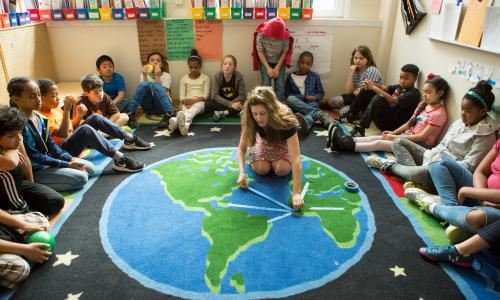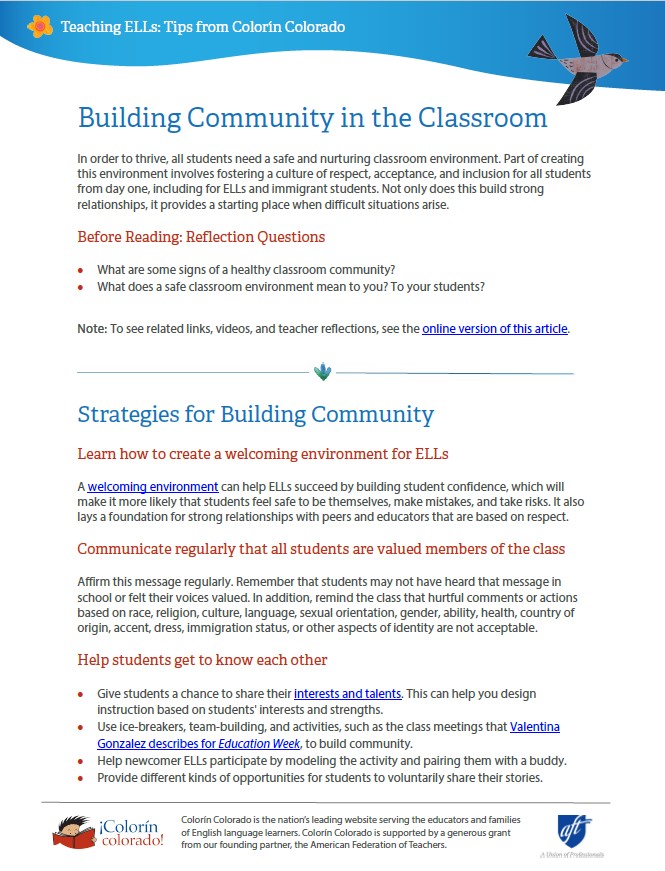Discussing Race and Racism with ELLs

This article includes tips for navigating conversations about race and racism with ELLs, as well as resources for further learning and reflection. This article is part of Navigating Tough Topics in the Classroom: Tips for ELL Educators.
Photo credit: A fourth-grade teacher maps out the route slave traders sailed during a lesson about the “New World.” Photo by Allison Shelley/The Verbatim Agency for EDUimages
Acknowledgements
 This project was made possible with support from the American Federation of Teachers.
This project was made possible with support from the American Federation of Teachers.
Racism, bias, and racially-charged violence can impact individuals from a diverse range of backgrounds. Your students may have encountered racism in different forms; they may also have strong opinions about public events or incidents they hear about on the news. If you are discussing racism with your English language learners (ELLs), whether because of the news or a planned lesson, you may find the following tips useful.
 Before Reading: Reflection Questions
Before Reading: Reflection Questions
- What are some of the questions and topics related to racism that have come up in your classroom in the past?
- How did those discussions play out?
- How comfortable or prepared do you feel to talk about race and racism in the classroom?
Related resources
You can find additional resources in Talking with Students About Racism and Violence: Resources for Educators.
Note: Some of the following tips and quotes include responses from a survey we did with a diverse group of ELL educators about this topic.
Creating a safe space
It is important to proceed with care and sensitivity in discussions related to race while also acknowledging the realities of racism's impact.
Keep in mind that:
- Racism and related bullying/violence impacts students from diverse backgrounds.
- Students may have experienced bias and discrimination related to other aspects of their identity such as religion, gender identity, or immigration status.
- ELLs and immigrant students may also have witnessed racism or bullying in school or in the community.
- ELLs may have encountered, or adopted, biases they see in their own family or culture.
In addition, students may find discussion of current events highly traumatic and may need some space, time, or additional support to process events. You can find additional tips on addressing tough topics in the rest of our related guide:
- Talking About Tough Topics
- When Your School Community Is Impacted by a Global Crisis
- Discussing political violence with ELLs, immigrants, and refugees
Finally, remember that students should never be put on the spot to share a personal experience, especially if they have a connection to an event being discussed in the class.
Why relationships matter
It's critical to take a step back and ask yourself what you know about your students, their experiences, and their perspectives. This process of discovery and getting to know your students takes time, but the better you know your students, the more effective your decisions about instruction will be, particularly around challenging topics such as race and racism.
Build relationships early on
Get to know your ELLs in informal and relaxed ways at the beginning of the year. Building trust through informal conversations about topics such as students’ interests also can create a foundation for more difficult topics in the future.
In addition, these relationships ensure that you have accurate information about students' backgrounds, the languages they speak, and their prior educational experience. This process of discovery will also highlight the rich diversity within the experiences of your students.
Avoid assumptions
Another important reason to build relationships is that getting to know your students can help prevent erroneous assumptions such as these:
- Dr. Ayanna Cooper, a co-editor of Black Immigrants in the United States: Essays on the Politics of Race, Language, and Voice, shares examples in the videos below in which educators assumed that Haitian Creole students were African Americans.
- In his book Solving Disproportionality and Achieving Equity, Dr. Edward Fergus of Rutgers University, who came to this country from Panama at the age of 9, shares the question he has gotten his whole life: "How can you be Black and speak Spanish?"
Encountering mistakes, stereotypes, and questions such as these can be confusing and painful for students. Encourage your colleagues to check their assumptions as well and to build meaningful relationships so they can prevent these situations from occurring.
You can find more ideas on developing these relationships in Parts I of this guide, Building Community.
Video: Avoiding assumptions related to Black immigrants
Video: Where Black students "are supposed to be"
Give students the opportunity to privately share their own experiences with racism, bias, and discrimination
It is helpful to know where your students are coming from around these issues. If you are discussing events related to racism and bias, you may wish to give students the option to share personal experiences privately through an optional journal question, such as, "What was one time you were treated like an outsider?" Some students may not wish to answer these questions, particularly if they have experienced trauma in connection with these events.
And if you are providing writing prompts, provide multiple topics for students who may not wish to share personal experiences. On the other hand, keep in mind that some students may wish to share their experiences and you may find some common ground in their responses that can build some empathy and community.
Note: Do not share any students' responses publicly without their permission.
Video: How school leaders can respond to anti-Asian bullying and violence
Talk with cultural liaisons or other colleagues to find out what kinds of racism and discrimination families in your communities have faced
It is helpful to know whether students might have experienced prejudice or persecution in their own home countries, as well as in the U.S. For example, one reason that many Indigenous families from Latin American operate in Spanish (their second language) and keep their Indigenous language and identity hidden is that they have experienced brutal violence and suppression in their home country.
At the same time, students who were part of a majority racial or ethnic group in their home country may not have experienced racism the same way that they may experience it in the U.S. This may be a new and confusing reality for them. As one Somali educator commented to a colleague, "I didn't know I was Black until I came to the U.S." Educators who work with these communities regularly may be able to share some important context around these issues.
Video: How I became an advocate for my Indigenous community
If you feel comfortable doing so, consider sharing any relevant experiences of your own
Personal stories are powerful and can help build empathy. Nelver Brooks, a Black ELL educator and advisor to Colorin Colorado, writes, "I share my personal experiences and tell my students their stories are important, too. I've learned that we are more alike than different...and that sometimes their experiences with racism and racialized violence have happened far earlier in some of their lives than my experiences did."
Video: What it felt like to be bullied
Principal Tam recalls his experiences being bullied as a young Chinese immigrant in the United States.
Creating a tone and culture of respect
Remind the class to treat each other with respect
Before starting any kind of activity or discussion, remind the class not only of your norms for classroom and discussion behavior but that everyone brings different kinds of background knowledge and experience to the conversation. You can find additional ideas for creating these norms in Part II of this guide, Creating Shared Expectations in the Classroom.
Look for ways to provide social-emotional support
As you get to know your students, look for ways to support their social and emotional well-being. That may be with check-ins, private time for journal writing, small group discussion, or the choice of how to participate. The better you know your students, the better you will be able to take their temperature in these moments. You can find more ideas in our section on social and emotional learning for ELLs.
Prepare for uncomfortable conversations
Conversations about race can get uncomfortable. While you can't always predict when these moments will occur, preparing beforehand may give you some tools that can help. You can start with the ideas laid out in:
In addition, Learning for Justice has published two in-depth resources that offer ideas for navigating and responding to challenging comments and conversations:
- Let's Talk: Facilitating Critical Conversations with Students
- Speak Up at School: How to Respond to Everyday Prejudice, Bias, and Stereotypes
Another resource is the book Ouch! That Stereotype Hurts, which offers lots of practical guidance and examples. There are training and extension activities related to the book available as well.
And after uncomfortable conversations have taken place, take some time to reflect on whether you might have handled anything differently or whether you need to check in with students following the discussion.
Consider using restorative practices circles
Look for training in how to use a restorative circle approach in which you can ask questions such as, "What are you hearing in the news? How does it make you feel? What are you wondering?"
The role of background knowledge
Identify students’ background knowledge on topics you will be discussing
Just as for any other topic, it’s important to identify the background knowledge that students bring to a topic, and the background knowledge they need. First, identify what they know. Then identify what questions they have and the areas of background they need. For example, ELLs and immigrant students may have many questions about protests for racial justice. Identify the most salient points that will help students understand the events you are discussing.
One ESOL educator who responded to our survey writes, "We do activators, polls, online discussions, shared documents, and low-stakes collaborative tasks to establish what they already know."
Look for opportunities to collaborate around background knowledge
Background knowledge can be a particularly complex topic to tackle in subjects such as social studies, history, and civics. When educators of ELLs work with content-area specialists, they can often identify key points together that can help students master the content successfully, as well as ways to tap into students’ existing knowledge.
Thinking about language
Teach the language students will need to understand the lesson
Identify the language students will need to be successful with material, such as key vocabulary words or phrases, words with multiple meanings, and examples of academic language. You can see some examples in this scaffolded lesson focused on Nelson Mandela’s speech, "An Ideal for Which I Am Prepared to Die," as well as in this collection of lessons on persuasive speeches from Stanford University’s Understanding Language initiative.
Be intentional about the language you use and teach
In addition to identifying the language you need for your lesson, consider your word choices (and assumptions that may be hidden in those choices). Review your materials carefully for any terms that may need additional context or perhaps an alternative way to express the same idea.
Extending the learning
Look for other connections to the curriculum
There are numerous connections to make across the curriculum on these topics, whether through the choice of literature students are reading or learning about the experiences of minority professionals in specific professions. Look for ways to make ongoing connections to deepen students’ learning and reflection on these important issues, as high school English teacher Keisha Davidson did with her students early in the pandemic.
One teacher who responded to our survey writes,
"We check in with students...about how they're doing with issues that are impacted by race (i.e., pandemic, anti-racist protesting and police response in Minneapolis) while supporting anti-racist messaging. We did a mental health unit with students that covered the impact of race on the incidence of mental illness in the US and the importance of mental health care when people are active in protesting, since this is a big topic in our city and we felt it was important to talk about how our students can impact systemic change around race but also deserve good mental health care as they do."
Look for extension resources
There are many different kinds of resources available to students of all ages, educators, and the public about race and racism. These include multimedia resources and videos, books, articles, and much more on a range of topics. We have compiled many of these resources here for further exploration: Talking with Students About Racism and Violence: Resources for Educators. Another teacher shared this idea in our survey:
"I find great read-aloud books to be extremely helpful with emotionally charged topics. It is something about the narrative being a very accessible format for students to empathize with others and coming to understand themselves. I keep lists of every book I read aloud and make note of how they compare using an Anti-bias checklist. I have a bookshop in my area that does a great job of finding diverse voices that might reflect the lives of my immigrant students' families...I fill my books with post-it notes where I plan to stop and ask questions along the way. Students share their answers with each other and then with the group, if they like. It is a simple thing -- but if you have the right book, it works very well."
Continue your learning and reflection
Conversations about topics such as race, culture, and language involve many points of intersectionality, where multiple identities connect and intersect. Taking time to reflect on the perspectives and experiences you bring to these conversations can inform not only how you manage the discussions but how you are able to grow through them.
You can find more resources to support this reflection here:
- Addressing Racism and Bias in Schools
- Continuum of Cultural Competency/Proficiency (Region 4 Education Service Center)
- Supporting Immigrant Students: Scenarios for Reflection
- Culturally Responsive Practice: Resources for Professional Development and Reflection
Create a community
Creating a community that is willing to listen, learn, and grow together can benefit the entire school (and larger community) by building relationships and laying a strong foundation for response should any incident occur. It is important to keep in mind, however, that the intersection of different issues or topics can be particularly complex. For example, in her work studying Black immigrants, Dr. Ayanna Cooper shared with us that in some groups she met, individuals felt comfortable speaking about race, but not immigration. In others, they felt comfortable speaking about immigration, but not race. It takes time to build trust and create safe spaces where individuals feel heard and seen; the more people are engaged, however, the stronger those communities will be and the more prepared they will be to dig into the points of intersection on complex topics.
How do we address adults' discomfort or resistance?
As noted above, these conversations can get uncomfortable -- for adults as well as students, and teachers may wish to avoid conversations related to race in order to avoid that discomfort. Yet students, many of whom may be experiencing the impacts of racism in a very personal way on a regular basis, are looking to adults for guidance and support. In order to build your own capacity to address race, racism, and other complex topics, you can:
- request staff training from professional experts in diversity, equity, and inclusion (DEI)
- request a mentor who has experience navigating these issues
- engage in professional development opportunities, webinars, and conferences from organizations like the Roots ConnectED, Learning for Justice, American Federation of Teachers, Facing History, the Anti-Defamation League and others that specialize in equity
In addition, you can encourage your colleagues to engage in these conversations by saying things like, "These conversations are hard, but our students need us not to be afraid of that discomfort." To take it a step further, share an article or resource that had an impact on you. These needles can be hard to move, but acknowledging and naming the discomfort is an important first step to the growth that is possible when we lean into it. To bring this point home, Dr. Christopher Emdin shares the following reflection in an interview with Larry Ferlazzo; while he is talking about educators working in urban schools, the lessons can be extended more broadly:
"The most valuable thing any urban educator can do before working in urban communities is to engage in deep reflective work about who they are, what biases they hold, and why they have chosen to work in these communities. This self-work is more important and rigorous than any academic work one may engage in on the path towards becoming an effective teacher...The teacher who knows who they are is more critical of how these biases are played out in their interactions with students and inevitably interacts with students more positively."
Related Resources
For guidance on other issues related to bias and bullying, see the following resource sections:

